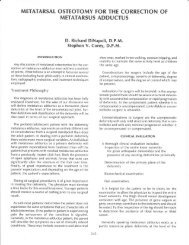Reappraisal of the Regnauld Procedure for Hallux Valgus and
Reappraisal of the Regnauld Procedure for Hallux Valgus and
Reappraisal of the Regnauld Procedure for Hallux Valgus and
Create successful ePaper yourself
Turn your PDF publications into a flip-book with our unique Google optimized e-Paper software.
CHAPTER 18<br />
8I<br />
1. Piot Hole - 2mr Drill<br />
lnitially D.ill wdh 0.062" K-wi.e<br />
Enlarge wiih 2.0 mm Dril Bat<br />
2. Dillwith Stop - 2.4 mm D.il<br />
Enlarge ONLY Phalangeal Base<br />
3. Depth Measuaemeni<br />
Generally 28-30 mm lengih<br />
4. Tap enti.e Lenglh ih.ough<br />
Latera, C€dex <strong>of</strong> Phalengeal Head<br />
5. lnserl Herbeft Screw so comp elely<br />
lnaraosseus<br />
6. Remove P.elimr.ary Fxalion (0.045" KVt4<br />
7. lnsed 2nd Foinl <strong>of</strong>Fixation<br />
0.062" KW anse*ed from Distal Tip otToe<br />
Cross both IPJ <strong>of</strong> <strong>Hallux</strong> & Osteotomy<br />
<strong>the</strong> wire through <strong>the</strong> articular surface; remember that <strong>the</strong><br />
phalangeal articular surface is concave. This wire, <strong>the</strong><br />
"rudder pin" will remain until <strong>the</strong> base is reinserted later<br />
in <strong>the</strong> procedure (Figure 4). It provides a reference point<br />
so that articular congruency will be maintained as well as<br />
providing a point <strong>for</strong> h<strong>and</strong>ling <strong>the</strong> fragment.<br />
If <strong>the</strong> surgeon chooses, alternatively <strong>the</strong> base may be<br />
left in place with dissection limited to that necessary <strong>for</strong><br />
osteotomy <strong>and</strong> fixation. For full decompression, <strong>the</strong> basal<br />
fragment is <strong>the</strong>n extirpated from <strong>the</strong> wound with care so<br />
as to minimize damage to its structure. The bone may be<br />
s<strong>of</strong>t <strong>and</strong> this <strong>of</strong>ten means avoidance <strong>of</strong> <strong>the</strong> points <strong>of</strong> bone<br />
<strong>for</strong>ceps to grasp <strong>the</strong> base during excision. A 6 inch Brown<br />
<strong>for</strong>ceps or guarded pressure with an alligator bone <strong>for</strong>ceps<br />
is usefui.<br />
Following its removal from <strong>the</strong> wound, <strong>the</strong> resected<br />
portion <strong>of</strong> proximal phalanx is wrapped in a damp sponge<br />
<strong>for</strong> later use. The surgeon may now address <strong>the</strong> proliferative<br />
bone or arthrosis <strong>of</strong> <strong>the</strong> first meratarsal. If <strong>the</strong> operadve<br />
pathology is one <strong>of</strong> hallux valgus, only limited dissecrion <strong>of</strong><br />
<strong>the</strong> first metatarsal is necessary. In cases <strong>of</strong> severe de<strong>for</strong>mity<br />
or first MTP joint arthrosis <strong>the</strong>n additional dissection may<br />
be required. This allows adequate exposure <strong>for</strong> peripheral<br />
cheilectomy <strong>of</strong> <strong>the</strong> osteophytosis. A sesamoidolysis may<br />
be per<strong>for</strong>med with inspection <strong>of</strong> all surfaces <strong>of</strong> <strong>the</strong><br />
metatarsal head <strong>and</strong> its sesamoids. Cheilectomy or<br />
removal <strong>of</strong> peripheral lipping <strong>of</strong> <strong>the</strong> sesamoids is possible<br />
as well as complete removal <strong>of</strong> a sesamoid if deemed necessary<br />
is quite easy from an intracapsular approach with<br />
<strong>the</strong> base removed from <strong>the</strong> wound.<br />
Alternativeiy, <strong>the</strong> base need not be excised but<br />
complete subperiosteal dissection along <strong>the</strong> medial<br />
aspect <strong>of</strong> <strong>the</strong> base <strong>of</strong> <strong>the</strong> proximal phalanx is necessary<br />
<strong>for</strong> both later internal fixation as well as providing some<br />
degree <strong>of</strong> joint rela-xation.<br />
With <strong>the</strong> phalangeal base removed from <strong>the</strong><br />
wound, te<strong>the</strong>ring <strong>of</strong> <strong>the</strong> flexor tendons to each o<strong>the</strong>r<br />
may be accomplished to aid in hallucal purchase <strong>and</strong><br />
help avoid later interphalangeal joint instabiliry postoperatively<br />
(Figure 5). A hallux maileus was identified in<br />
some <strong>of</strong> <strong>the</strong> early cases postoperatively <strong>and</strong> this is now a<br />
routine maneuver to avoid this complication.<br />
The excised portion <strong>of</strong> <strong>the</strong> phalangeal base is<br />
remodeled. A]l s<strong>of</strong>t tissue attachmenrs ro <strong>the</strong> base should<br />
be removed. Usually, this is begun with a rongeur<br />
followed by decortication <strong>of</strong> <strong>the</strong> periphery <strong>of</strong> <strong>the</strong> base<br />
per<strong>for</strong>med with a rotary drill <strong>and</strong> side-cutting oval or<br />
round bur (5 mm). The h<strong>and</strong> rongeur is also helpful in<br />
resecting <strong>the</strong> periarticular lipping or osteophytosis that<br />
may be present.<br />
Following remodeling, a small kirschner wire is<br />
used to per<strong>for</strong>ate <strong>the</strong> entire remaining corrical surface a<br />
few millimeters to aid in revascularization <strong>and</strong> avoidance<br />
<strong>of</strong> avascular necrosis (Figure 6). These holes are similar to<br />
those placed in any bone graft to encourage revascularization.<br />
A 0.028 inch kirschner wire is utilized to drill 25 to<br />
35 holes around <strong>the</strong> entire osseous circumference <strong>of</strong> <strong>the</strong><br />
phalangeal base. Here, care must be taken to avoid<br />
drilling into <strong>the</strong> articular surface due to <strong>the</strong> concave<br />
geometry <strong>of</strong> <strong>the</strong> articular surface.<br />
The wound is copiously irrigated <strong>and</strong> <strong>the</strong> graft is<br />
reinserted using <strong>the</strong> "rudder pin" as a reference or guide to<br />
its placement to re-establish a congruous first MTP joint.<br />
A0.045 in. kirschner wire placed from <strong>the</strong> medial surface<br />
<strong>of</strong><strong>the</strong> re-inserted base into <strong>the</strong> lateral cortex <strong>of</strong><strong>the</strong> phalanx<br />
is used <strong>for</strong> preliminary fixation. Definitive fixation is<br />
per<strong>for</strong>med with insertion <strong>of</strong> a Herbert or Bold screw.<br />
Fixation with <strong>the</strong> Herbert bone screw will be<br />
described as this has been <strong>the</strong> most common <strong>for</strong>m <strong>of</strong><br />
fixation per<strong>for</strong>med, Figure 7. Fixation with a Herbert<br />
bone screw inserted from <strong>the</strong> plantar medial aspecr <strong>of</strong> <strong>the</strong><br />
base into <strong>the</strong> distal lateral aspect <strong>of</strong><strong>the</strong> phalanx has been<br />
very effective. Alternatively, <strong>the</strong> Bold Screw has been used

















